
Bibliografische Information
DIN A 4,
202 Seiten,
1. Edition (translated from German ed. 2020) including IEC/IEEE 82079-1 2020
ISBN 978-3-96393-004-1 (softcover with standard text)
PDF,
138 Seiten,
1. Edition (translated from German ed. 2020) without IEC/IEEE 82079-1 2020
ISBN 978-3-96393-005-8 (ebook PDF without standard text)
Implementation of IEC/IEEE 82079-1 Ed. 2
Considering other Sector-Specific Standards
Autor(en):
Tillmann,
Fritz,
Klumpp,
Rieder,
Schmeling,
Schneider
Verlag: tcworld GmbH
- Themen:
- Kategorien:
- Stichworte:
- Normen
- 82079-1
- Betriebsanleitung
135,00 €
(für Mitglieder 95,00 €)
softcover with standard text,
202 Seiten
Lieferzeit: 5-7 Arbeitstage
Status: Verfügbar
85,00 €
(für Mitglieder 55,00 €)
ebook PDF without standard text,
138 Seiten
Lieferzeit: 2-3 Arbeitstage
Status: Verfügbar
Kurzbeschreibung
Die IEC/IEEE 82079-1 ist die wichtigste Norm für die Erstellung aller Arten von Nutzungsinformationen – von der Farbdose bis zur Industrieanlage. Der neue Praxisleitfaden erläutert praxisnah die zentralen Anforderungen der grundlegend überarbeiteten Norm. Er enthält zudem alle wichtigen Neuerungen sowie in der Printversion den englischsprachigen Text der Norm.
Über das Buch
IEC/IEEE 82079-1 is of excelling importance for the field of technical communication. Since its publication in 2012, it defines the general principles and requirements for instructions for use in all industry branches.
In a five-year effort the standard has been substantially revised by an international work group formed by 21 experts from nine countries.
This implementation guide focuses on the practical application of the standard and in this effort largely follows the improved
structure of the standard: All chapters r eferring to specific requirements of the standard include a table presenting the “mandatory requirements” of the respective section. The following subchapters then discuss the requirements and their implementation, including practical e xamples.
The practical implementation guide thus is ideally suited to understanding the requirements set forth in the standard and their implementation. Thanks to its structure following that of the standard, it can also be used as a reference.
Inhaltsverzeichnis
-
Introduction
1.1 Why was the standard revised?
1.2 Who shared in the revision?
1.3 Participation of tekom and the share of the authors of the present publication
1.4 Who are in the target audience of this practical implementation guide?
1.5 Normative contents and innovations
1.6 Structure of this implementation guide
-
Pertinent changes and references to other standards
2.1 Paradigm shift: From document to information
2.2 Title of the standard
2.3 Scope
2.4 Information types and information management
2.5 IEC/IEEE 82079-1 as a horizontal standard
2.6 Normative references
-
Groups of important terms
3.1 Documents and information products
3.2 Target audiences and user groups
3.3 Products
3.4 Information structures
3.5 Process
3.6 Safety
3.7 Quality
-
Fulfilment of the requirements of the standard
-
Principles
5.1 General
5.2 Purpose of information for use
5.3 Information quality
5.4 Use of repeatable processes
-
Information management process
6.1 General
6.2 Analysis and planning of information
6.3 Design and development, including review, editing, and testing
6.4 Production and distribution
6.5 Sustainment, maintenance and improvement
-
Content of information for use
7.1 General
7.2 Identifiers
7.3 Importance of retaining printed information for use
7.4 Presentational conventions
7.5 Terminology
7.6 Acronyms, abbreviations, technical terms
7.7 Explanation of safety signs, graphical symbols and markings
7.8 Product description
7.9 Supplied accessories, consumables, spare parts
7.9.1 Accessories supplied with the product
7.10 Information for use needed during the lifetime of the supported product
7.11 Safety-related information
7.12 Instructions for assembly of self-assembly products
7.13 Information for use for complex systems (plant documentation)
7.14 Information security and data privacy
7.15 Training
-
Structure of information for use
8.1 General
8.2 Information types
8.3 Structuring
8.4 Navigation and information delivery
-
Media and format
9.1 General 98
9.2 Durability of chosen media
9.3 Use of animations or audio-visual demonstrations
9.4 Location and availability
9.5 Printable information
9.6 User interaction and search features
9.7 Downloadable information for use
9.8 Suitability for the conditions of use of the supported product
9.9 Consistency of format
9.10 Legibility, readability and comprehensibility
9.11 Use of visualization
9.12 Use of tables
9.13 Use of colours
9.14 Use of icons
9.15 Attracting attention to safety-related information
-
Professional competencies
10.1 General
10.2 Task-related competencies
10.3 Levels of proficiency
10.4 Competencies of translators
-
The relation between IEC/IEEE 82079-1 and product or sector-specific standards
11.1 Product and sector-specific requirements take priority over general requirements
11.2 Sample presentation of the interfaces between EN ISO 20607 and IEC/IEEE 82079-1
11.3 EN ISO 20607 and IEC/IEEE 82079-1 compared side by side
11.4 Applying several standards at a time
-
Appendix
12.1 Requirements for the content of information for use set forth in the Machinery Directive (2006/42/EC)
12.2 Limits of machinery
12.3 Phases of life of the machinery
12.4 Example for a table of contents
12.5 Examples of methods for determination of signal words
-
Literature
-
Table of figures and tables
-
Authors
zurück
